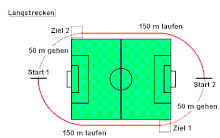Helsen test
The Helsen test , also known as the FIFA fitness test , is a procedure for checking the physical performance of football referees and assistant referees . It was developed by and named after the Belgian professor and member of the UEFA Referee Instructors Committee, Werner Helsen. The test has been mandatory for the referees of the national associations since 2007 and replaced the Cooper test , which until then had been decisive for football referees . The test was used for the first time to prepare for fitness in the run-up to a major tournament in connection with the 2008 European Football Championship . The Helsen test examines the speed and the ability to complete strenuous runs with changing speed requirements, two essential criteria of physical performance for referees in top-class sport . The test consists of a sprint and an interval test, which must be completed one after the other at the prescribed times. For referees at the lower levels of the national and regional associations, it is carried out in modified forms with lower requirements, e.g. omitting the sprints or a higher time budget for sprints and / or the interval runs.
The advantage over the Cooper test is that it simulates the reality of a soccer game , its actual profile of requirements for the referees during a game control with many short sprints, longer stretches at fast pace and walking breaks, than a continuous 12-minute run with its monotonous pace , which is not required in this form by a referee during a game.
Sprint test (short distances)
First, six sprints of 40 meters each have to be completed with a recovery time of 90 seconds each. The so-called flying start sprints must be completed in 6.2 seconds for FIFA referees (women 6.6 seconds). There are higher sprint requirements for assistant referees (6.0 seconds). The forefoot stands on a line 1.5 meters from the electronic timing barrier at the start. If a referee falls or stumbles during a sprint, he has one more try. If a referee exceeds the required time in one of the six attempts, he may start another attempt immediately after sprint six. However, if two attempts are unsuccessful, the test is considered failed.
Interval test (long distance)
This is followed by 10 interval laps on a 400 m running track . For each round of the stadium, 2 × 150 meters must be run in 30 seconds (FIFA referee). When walking 50 meters, the referee can recover 35 seconds after every 150-meter run (150 m + 50 m + 150 m + 50 m = 400 m). Depending on the technical and organizational conditions, the interval runs are carried out in groups of four to seven people. The individual groups start at two or four different points on the track. The test supervisor announces the beginning and end of an interval with a whistle. At this point in time, the respective part of the route must be covered by the participants. If a runner stays twice over the permitted time, he is eliminated and the test is considered to have failed. Here, too, the time requirements are usually graduated in the national and state associations as well as in the women's area.
Comprehensive measurement options are required for the execution of the tests and therefore the use of extensive technical aids is necessary. In the FIFA area, every runner is equipped with a chip that triggers a measuring signal when passing a measuring station. This determines the time in which the runner has covered the specified distance.
Individual evidence
- ↑ Plautz passed the EURO referee test
- ↑ a b FIFA Fitness Tests for Referees and Assistant Referees 1 ( Memento from September 23, 2015 in the Internet Archive )
Web links
- FIFA Fitness Test (PDF; 0.4 MB), accessed on February 28, 2019
- Plautz passed the EURO referee test , accessed on September 21, 2010
- The referees in the fitness test (film)
- German Football Association: Promoting talent for young referees in the NFV , accessed on February 28, 2019
